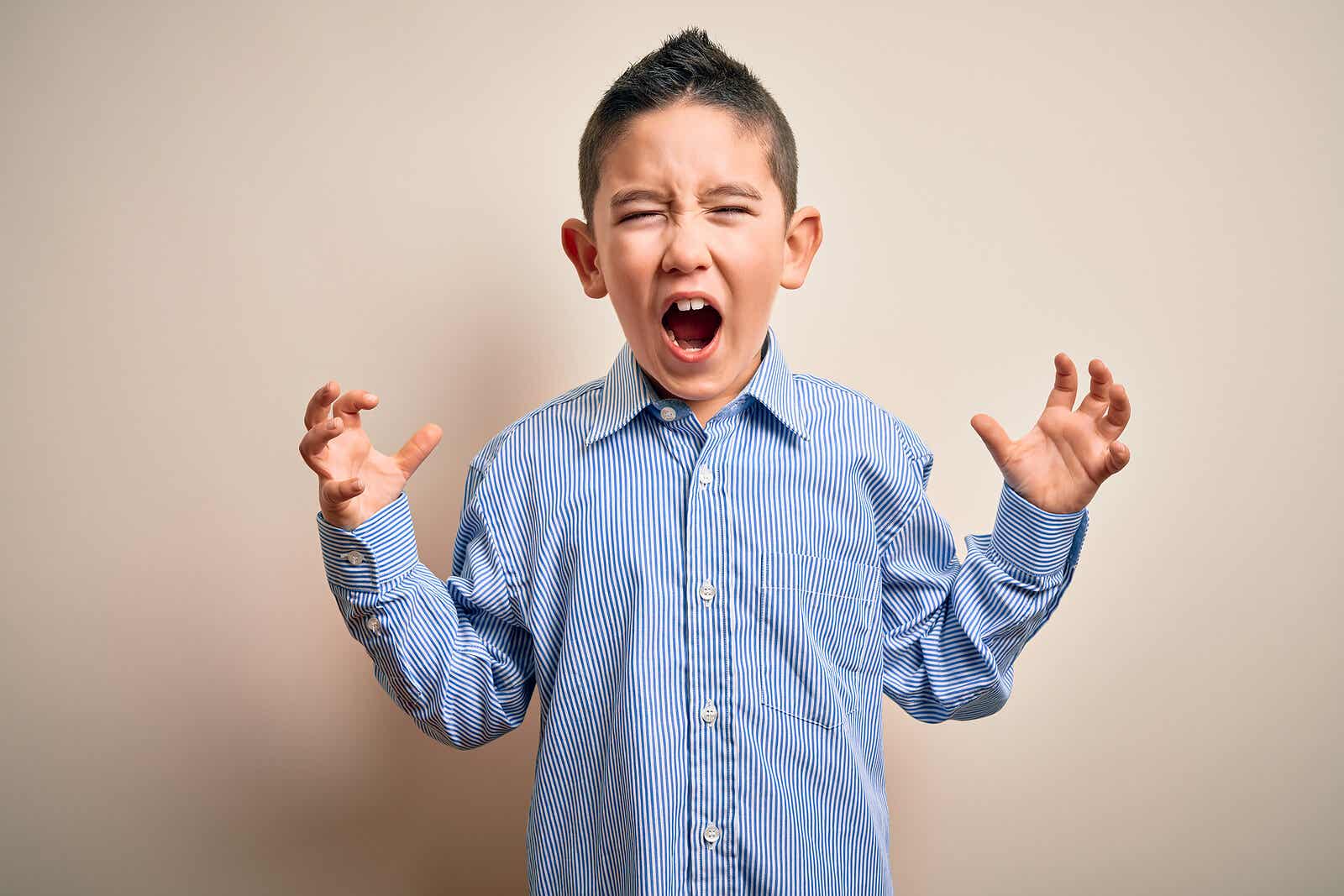8 Techniques to Help Children Manage Their Anger


Written and verified by the psychologist Mara Amor López
Anger is one of the primary emotions of the human being and is the one that causes us irritability or rage in situations that we don’t like or that cause us frustration. And the same thing happens to children. Sometimes, children feel anger so intensely that they’re not able to control it. In the following lines, we’re going to see some techniques to help children to manage their anger.
Anger’s expressed in two ways in our body. On the one hand, we experience it internally, accelerating the heart rate and increasing blood pressure and the production of adrenaline. On the other hand, we express it externally, through the change of expression it produces in our faces, our elevated tone of voice, the tensing of our muscles, etc.
In situations in which children feel anger, they may shout, hit, throw objects, or insult. What can we parents do if our children act with anger? Let’s try to give an answer to this.
Techniques to help children manage their anger
Anger isn’t a pleasant emotion for anyone, but we can’t say it’s a bad thing, as we can learn a lot from it.
It’s normal that, when faced with a certain situation that causes frustration for children, kids feel anger. As parents shouldn’t invalidate that emotion with our words or behavior, since we’ll only make them feel worse.

With that in mind, parents have to help children to manage their anger, and we can do it through some techniques such as the ones we’re going to discuss below.
“Don’t teach children never to be angry; teach them how to be angry.”
-Lyman Abbot-
Helping to recognize anger
When a child’s immersed in a fit of anger, it’s very difficult to talk to him, so we must wait for this event to pass to have a conversation about what’s happened. We have to ask them why they reacted this way and how they feel after this episode. All this is in order for the child to become aware of their emotions and to know why they experience them.
Keep calm and avoid yelling
Parents have to set an example and we shouldn’t lose our own temper, scream and shout, shake the child, or slam the door. If we want the child to learn to manage their anger, they must see in us an example of controlling that same emotion, even though there are situations in which it’s easy to lose your patience.
We also run the risk that, by reacting in an aggressive or violent way, the child’s anger and tantrum will increase even more.
“When we exchange angry words for angry words, nasty face for nasty face, slamming door for slamming door, and tear them down with our words because they tore us down with theirs, they will never feel remorse for their own actions. We have hijacked that teachable moment.”
-Wendy Speake-
Teaching children to act without anger
On many occasions, children react with anger because they don’t have enough skills to control it and don’t know how they can solve the problem in which they are immersed. For this reason, we must teach them to:
- Identify what provoked that emotion of anger.
- Talk to them about what happened and explain to them that this way of acting isn’t appropriate, and how they can act better on another occasion.
- Help them look for solutions for future difficult situations.
- Reinforce the child when they respond to a situation in a calm manner.
Switch to another activity
When the child begins to feel the emotion of anger, we can help him by switching to another activity that’s fun for them. This way, we’ll get him out of that state of frustration. For example, you can try the following:
- Tell stories while looking at pictures.
- Play a board game with the family.
- Watch a movie that they like a lot.
- Play with play dough and make figures.
- Make a calm jar and use it when he/she feels angry.
- Draw a picture while listening to music.
Physically get out of the situation
You can also try to physically remove your child from the situation that’s producing anger with actions such as the following:
- Go for a walk with dad, mom, or both.
- Go out to the yard, if you have one.
- Find a corner that brings calm and tranquility for your child to relax.
More techniques to help children to manage anger

Teaching tension release
Let’s look at some of the ways you can help children release tension:
- Sports. Sports are excellent for anger and stress management, as they release endorphins that help to give a sense of calm and well-being. In addition, they use up children’s excess energy.
- Relaxation or breathing techniques. Kids can use these techniques any time but especially at times when they’re feeling anger, as they’ll help them calm down.
- Activities such as yoga or mindfulness can also help.
Encourage empathy to help children manage their anger
It’s very important to teach and encourage empathy in children so that they understand how others feel and know how to put themselves in the other person’s shoes. This is fundamental for them to be able to manage their anger, so we must transmit this value to children from a young age.
Teaching self-control strategies
We can show our children some techniques that will help them have self-control when they’re feeling anger, such as, for example, the traffic light technique.
With this method, we will indicate to the child, by means of yellow, red, and green cards, if they should stop, if they should analyze what’s happening and why they’re behaving a certain way, or so that they can express what they’re feeling.
In short, if it’s sometimes difficult for adults to control their anger, then it’s even harder for children, as they don’t yet have control over their emotions. The younger a child is, the harder it will be for them to handle this emotion. So, these techniques to help children manage their anger can be very useful.
It’s true that not all children react to situations with anger, but if they do, parents are responsible for teaching them how to manage this emotion. With patience and love, everything’s possible.
Anger is one of the primary emotions of the human being and is the one that causes us irritability or rage in situations that we don’t like or that cause us frustration. And the same thing happens to children. Sometimes, children feel anger so intensely that they’re not able to control it. In the following lines, we’re going to see some techniques to help children to manage their anger.
Anger’s expressed in two ways in our body. On the one hand, we experience it internally, accelerating the heart rate and increasing blood pressure and the production of adrenaline. On the other hand, we express it externally, through the change of expression it produces in our faces, our elevated tone of voice, the tensing of our muscles, etc.
In situations in which children feel anger, they may shout, hit, throw objects, or insult. What can we parents do if our children act with anger? Let’s try to give an answer to this.
Techniques to help children manage their anger
Anger isn’t a pleasant emotion for anyone, but we can’t say it’s a bad thing, as we can learn a lot from it.
It’s normal that, when faced with a certain situation that causes frustration for children, kids feel anger. As parents shouldn’t invalidate that emotion with our words or behavior, since we’ll only make them feel worse.

With that in mind, parents have to help children to manage their anger, and we can do it through some techniques such as the ones we’re going to discuss below.
“Don’t teach children never to be angry; teach them how to be angry.”
-Lyman Abbot-
Helping to recognize anger
When a child’s immersed in a fit of anger, it’s very difficult to talk to him, so we must wait for this event to pass to have a conversation about what’s happened. We have to ask them why they reacted this way and how they feel after this episode. All this is in order for the child to become aware of their emotions and to know why they experience them.
Keep calm and avoid yelling
Parents have to set an example and we shouldn’t lose our own temper, scream and shout, shake the child, or slam the door. If we want the child to learn to manage their anger, they must see in us an example of controlling that same emotion, even though there are situations in which it’s easy to lose your patience.
We also run the risk that, by reacting in an aggressive or violent way, the child’s anger and tantrum will increase even more.
“When we exchange angry words for angry words, nasty face for nasty face, slamming door for slamming door, and tear them down with our words because they tore us down with theirs, they will never feel remorse for their own actions. We have hijacked that teachable moment.”
-Wendy Speake-
Teaching children to act without anger
On many occasions, children react with anger because they don’t have enough skills to control it and don’t know how they can solve the problem in which they are immersed. For this reason, we must teach them to:
- Identify what provoked that emotion of anger.
- Talk to them about what happened and explain to them that this way of acting isn’t appropriate, and how they can act better on another occasion.
- Help them look for solutions for future difficult situations.
- Reinforce the child when they respond to a situation in a calm manner.
Switch to another activity
When the child begins to feel the emotion of anger, we can help him by switching to another activity that’s fun for them. This way, we’ll get him out of that state of frustration. For example, you can try the following:
- Tell stories while looking at pictures.
- Play a board game with the family.
- Watch a movie that they like a lot.
- Play with play dough and make figures.
- Make a calm jar and use it when he/she feels angry.
- Draw a picture while listening to music.
Physically get out of the situation
You can also try to physically remove your child from the situation that’s producing anger with actions such as the following:
- Go for a walk with dad, mom, or both.
- Go out to the yard, if you have one.
- Find a corner that brings calm and tranquility for your child to relax.
More techniques to help children to manage anger

Teaching tension release
Let’s look at some of the ways you can help children release tension:
- Sports. Sports are excellent for anger and stress management, as they release endorphins that help to give a sense of calm and well-being. In addition, they use up children’s excess energy.
- Relaxation or breathing techniques. Kids can use these techniques any time but especially at times when they’re feeling anger, as they’ll help them calm down.
- Activities such as yoga or mindfulness can also help.
Encourage empathy to help children manage their anger
It’s very important to teach and encourage empathy in children so that they understand how others feel and know how to put themselves in the other person’s shoes. This is fundamental for them to be able to manage their anger, so we must transmit this value to children from a young age.
Teaching self-control strategies
We can show our children some techniques that will help them have self-control when they’re feeling anger, such as, for example, the traffic light technique.
With this method, we will indicate to the child, by means of yellow, red, and green cards, if they should stop, if they should analyze what’s happening and why they’re behaving a certain way, or so that they can express what they’re feeling.
In short, if it’s sometimes difficult for adults to control their anger, then it’s even harder for children, as they don’t yet have control over their emotions. The younger a child is, the harder it will be for them to handle this emotion. So, these techniques to help children manage their anger can be very useful.
It’s true that not all children react to situations with anger, but if they do, parents are responsible for teaching them how to manage this emotion. With patience and love, everything’s possible.
All cited sources were thoroughly reviewed by our team to ensure their quality, reliability, currency, and validity. The bibliography of this article was considered reliable and of academic or scientific accuracy.
- Pearce, J. (1995). Berrinches, enfados y pataletas: soluciones comprobadas para ayudar a tu hijo a enfrentarse a emociones fuertes (Vol. 3). Grupo Planeta (GBS).
- Pearce, J. (1996). Peleas y Provocaciones: Cómo ayudar a tu hijo a controlar su agresividad (Vol. 20). Grupo Planeta (GBS).
- Cárdenas Cañizales, E. I. (2008). Programa de educación emocional basado en la terapia racional emotiva conductual de una muestra de niños de 9 a 10 años que presentan deficiencias en el control y la expresión apropiada de la ira, en el Centro Educativo Básico General República de México, ciudad de Panamá (Doctoral dissertation, Universidad de Panamá).
This text is provided for informational purposes only and does not replace consultation with a professional. If in doubt, consult your specialist.








